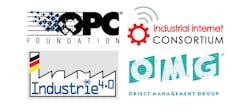The dust is far from settled after the explosion of the Internet of Things (IoT) onto the industrial scene just a few years ago. Many questions remain on a number of issues—ranging from mundane system integration issues to complex, cross-company security measures. As a result, some confusion still surrounds IoT and the organizations positioning themselves to support it.
One of the clearest examples of this confusion could be seen in the line of questioning recently presented to Stefan Hoppe, vice president of the OPC Foundation, in an interview with a German industrial media site. Hoppe sent me a translation of the interview to help clear up any similar misunderstandings that might also exist on this side of the Atlantic.
One of the issues brought up in the interview was the impression that the Industrial Internet Consortium (IIC) is much further ahead in developing an IoT framework than its German Industry 4.0 counterparts, despite Industry 4.0’s earlier start and support by the German of government.
Hoppe cleared up this misunderstanding by noting that the “content and recommendations of the RAMI 4.0 paper (Reference Architectural Model Industrie 4.0) were completed quite some time ago, although under the auspices of the associations they were not allowed to be published.” Hoppe says the reason the papers were not published earlier is that, according to their statutes, “the associations (connected to RAMI 4.0) may not issue specific recommendations.”
Despite the restrictions on its release, Hoppe says that, for a strategy paper such as RAMI 4.0, “such recommendations are essential to minimize a proliferation of technologies and interfaces. Therefore, after the restructuring of the (RAMI 4.0) platform under political leadership, the paper was released at Hanover Fair 2015.”
Comparing the IIC framework and RAMI 4.0, Hoppe says that beyond the “list of issues that should be taken into account or examined” in the IIC’s framework, “RAMI 4.0 contains a concrete list of key technologies as a recommendation for action for different layers of the reference architecture, including OPC Unified Architecture (UA) for the communication layer.”
Speaking of OPC UA, two technology areas creating some of the greatest confusion in industry around IoT are DDS (Data Distribution Service)—often referenced by IIC—and OPC UA. The confusion surrounding these technologies stems from the fact that both are promoted as protocols enabling interoperability between devices, machines, and systems. According to Hoppe, “DDS offers deterministic communication and is therefore comparable to Profinet or EtherCAT. The aim is fast data exchange within the systems. OPC focuses on interoperability—the exchange between systems. Above all, OPC UA offers security and configurable access control to interfaces and data. This is crucial for machine services.”
He adds that IIC members such a General Electric, Cisco, Microsoft, Oracle, and Siemens are “keen to use OPC UA” and that he is “not aware of any controllers or field devices in the automation sector that have implemented DDS” to date. However, discussions are currently underway to connect the two technologies. A meeting was recently held in Berlin “to clarify whether OPC UA should be recognized via the DDS transport layer,” Hoppe says. Even though the market hasn’t yet requested this connection, “experts are working on a gateway between OPC UA and DDS like we did with Sercos and EtherCAT. After all, this makes sense in order to integrate any DDS devices with OPC UA into the worldwide IoT community.”
Another point brought up in the German media interview with Hoppe questioned the connection between IIC and the Object Management Group (OMG). To help clarify questions about this relationship, I reached out to Dr. Richard Soley, who happens to be chairman and CEO of OMG as well as executive director of IIC.
“The Object Management Group (OMG) isthe parent company of the Industrial Internet Consortium (IIC),” says Soley.“This organization (OMG) has been in existence for 26 years and has a strong track record of innovation and membership all over the world.Besides its decades-long dedication to standards, the OMG has a long history of hosting non-standards-related communities dating back to the Service Oriented Architecture Consortium and including consortia focused on software quality, green computing, business process management, cloud computing, and now the industrial Internet. IIC is an independently run group and has separate standards liaisons not only with the OMG, but with about a dozen other organizations including GS1, JTC 1, OASIS, The Open Group, and the Open Interconnect Consortium. Decisions on what standards are to be used in testbed development are decided upon by the organizations leading a testbed and not the Industrial Internet Consortium itself.”
In my communications with Dr. Soley and Tom Burke, OPC Foundation president and executive director, they both were eager to spotlight the high degree on ongoing cooperation between their organizations.
“Richard, I and our respective organizations will be working together as we formalize very important liaisons between our respective organizations,” says Burke. “The OPC Foundation firmly supports the activities of both IIC and OMG and is looking forward to a very productive and proactive working relationship between the OPC Foundation and OMG, and between the OPC Foundation and IIC. We already have a technology development under way between OPC and OMG, and there will soon be a number of marketing and technology innovations between our respective partnerships.”
Leaders relevant to this article:


